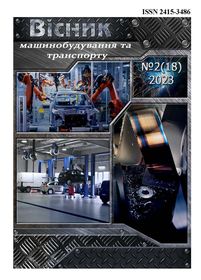Optimization passenger transport on basic organizations of uniform suburban passenger flow
DOI:
https://doi.org/10.31649/2413-4503-2023-18-2-183-189Keywords:
passenger transportation, passenger flow, passenger transport system, cost minimization, iteration process, urban agglomerations, transport problem, mathematical model.Abstract
The purpose article is improveefficiency of suburban passenger transportation based on organization of suburban passenger traffic. It was established that suburban passenger flow urban agglomerations consistsof following aggregated groups (segments): workers with variable work schedules, office workers, students, other passengers, while the total volume of passenger flow and the value individual components its segments are unstable and characterized by spatial and temporal unevenness.
The task organization of passenger traffic is find a compromise between the needs passengers and possibilities of transport. The compromise is achieved due fact by obtaining formal optimum each time, with help of variable weighting factors, it is possible display priorities passenger flows from different stations and sections. The task optimizing functioning of passenger transport system ofurban agglomeration based on organization passenger flow is minimize total costs transportation and waiting. The optimization criterion is determined based on minimization costs mastering passenger flow in full, as well as waiting by passengers at departure station and delay at destination station.
The article formulates problem of organizing suburban passenger flows in urban agglomerations reduce static reserves of suburban passenger complex at expense dynamic ones. The optimization apparatus based on dynamic transport problem was chosen and substantiated. The possibilities using method of dynamic coordination solve transport problems of urban agglomerations are analyzed and advantages are shown. The technology using optimization apparatus is proposed, which includes directed iterative process, which allows reduce the number of experiments for choosing among optimal options, most client-oriented compromise option. The method optimal organization of homogeneous suburban passenger flow based on method dynamic coordination has been developed. It was established use directed iterative process allows significantly reduce number of experiments in order achieve consensus betweeninterests passengers and efficiency of transport system.
References
Про схвалення Національної транспортної стратегії України на період до 2030 року: розпорядження Кабінету Міністрів України від 30 травня 2018 р., № 430-р. / Кабінет Міністрів України. URL: https://zakon.rada.gov.ua/laws/show/430-2018-%D1%80#Text (дата звернення: 31.03.2021).
Кашканов А. А., Пальчевський О. В. Проблеми функціонування транспортних систем великих міст України в сучасних умовах. Сучасні технології в машинобудуванні та транспорті. 2022. № 1(18). С. 97–102. URL: https://doi.org/10.36910/automash.v1i18.764
Коцюк О. Я., Григорчук О. Д. Мотивація пасажирів при виборі виду сполучення. Зб. праць Національного транспортного університету та Транспортної академії України. Київ: РВВ НТУ, 2000. Вип. 4. C. 162–163.
Методологічні основи проектування та функціонування інтелектуальних транспортних і виробничих систем: монографія / Аулін В. В. та ін. Кропивницький: Лисенко В. Ф., 2020. 428 с.
Batty K. W., Axhausen M., Giannotti F., Pozdnoukhoveds A. Smart cities of the future. The European Physical Journal Special Topics. 2012. Vol. 214, iss. 1. Р. 481–518.
Yogita B., Raghavendra P. Traffic Prediction for Intelligent Transportation System Using Deep Learning. International Journal of Research in Engineering, Science and Management. 2022. No. 7(5). Р. 61–62.
Ensemble Deep learning for Regression and Time Series Forecasting / Qiu X. at al. IEEE Symposium Series on Computational Intelligence, 2014. Р. 1–6. URL: https://doi.org/10.1109/CIEL.2014.7015739
Luo X., Li D., Yang Y., Zhang S. Spatiotemporal traffic flow prediction with KNN and LSTM. Journal of Advanced Transportation. 2019. No. 5. Р. 1–10. URL: https://doi.org/10.1155/2019/4145353
Implementing an Intelligent Transportation System: A Bottom-Up Approach to Value Creation. Connect, collect, analyze, deliver-optimize traffic management with intelligent transportation systems. [Online]. URL: https://intellias.com/implementing-intelligent-transportation-system/
Downloads
-
PDF (Українська)
Downloads: 134



